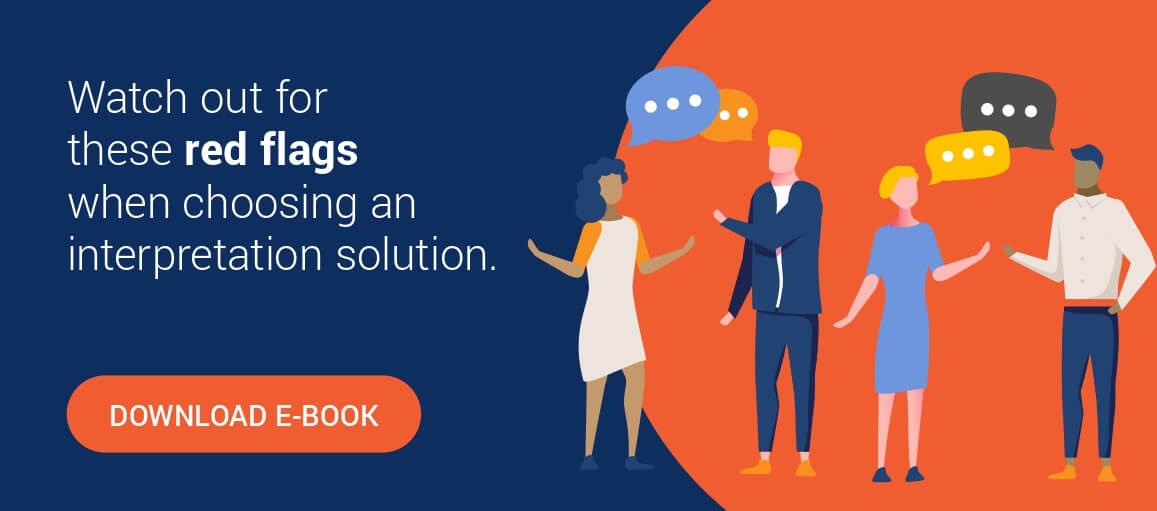Over the past two years, most of us have taken an unexpected crash course in video conferencing, from work meetings and conferences to safely distanced family get-togethers. Schools, hospitals, and city halls around the country have followed suit. From remote webinars to town hall meetings to patient education classes to academic IEP, Americans are reaping the benefits that remote access provides.
Something that often gets overlooked is the need to make a video platform accessible to all participants, including those who speak another language. Remote simultaneous interpretation (RSI) allows you to conduct virtual meetings while prioritizing accessibility and inclusivity. You just need to know where to start.
By partnering with an established, reputable language solutions partner, you can initiate remote simultaneous interpretation functionality with ease. In this article, we’ll go over best practices to consider when incorporating remote simultaneous interpretation into your video platform with the help of a language solutions partner.
1. Make sure interpreters have the right tools to get started.
Remote simultaneous interpretation offers equitable language access for participants of all language backgrounds, but only if interpreters have the tools they need to execute their role properly. Remote simultaneous interpretation involves all parties receiving audio and video with live interpretation at the same time, which is why it’s so important that both audio and video quality are excellent.
The right language solutions partner will work with you to ensure that each interpreter has the equipment they need to be successful. Every interpreter should have a working headset, microphone, webcam, and strong internet connection to ensure that remote simultaneous interpretation syncs with your platform software in real-time.
Interpreters must be able to understand, analyze, and interpret spoken or signed language without distraction or muffled utterances. In the case of patient education classes, for example, it’s best to use remote simultaneous interpretation to maintain the pace of class as the interpreter concurrently relays the speaker's message. If consecutive interpretation is used, which is a start-stop method, it extends required class time because it only allows the translation of one language at a time. Individuals trained specifically as simultaneous interpreters offer an advantage, which is why it is crucial to team up with a language solutions partner who has skilled and specialized interpreters at their disposal.
2. Conduct a tech check and trial run.
Test equipment ahead of time, especially in the case of remote simultaneous interpretation for video platforms with its many moving parts—from tech to scheduling, speakers, and content. Make sure that the language partner you’ve contracted invites interpreters and all event speakers to carry out a brief tech check prior to the event’s kickoff. Together, interpreters and event hosts can then test all audio equipment, walk through the video platform functionality and settings, go over the itinerary, and resolve any outstanding issues.
At ULG, we walk event hosts and interpreters through the video platform when conducting remote simultaneous interpretation for clients. The result is a clear, succinct video conference with smooth transitions with an accessible format all attendees on the call can actively participate in.
3. Provide interpreters with relevant materials in advance.
In order to provide high-quality interpretation, interpreters need time to prepare in advance. After contracting with a language solutions partner, make sure that interpreters have materials about the video conferencing event, host, participants, and any other relevant information. You can also include proper nouns such as names of people, places, and programming that you expect to cover during the call so the interpreter can plan accordingly.
This may seem like a small step, but it makes a huge difference during the live call. Especially with simultaneous interpretation, the stakes can be high; there’s essentially no do-over. By giving interpreters time to prepare, you’ll improve the accuracy of the interpretation and the experience for the interpretation recipients.
4. Choose a robust virtual meeting platform.
When it comes to best practices for incorporating remote simultaneous interpretation into your video platform, don’t overlook the video platform itself. In fact, some video platforms are notoriously ill-equipped to handle remote interpretation. Free platforms may work fine for the average professional or casual video call, but they’re prone to glitches, which causes pauses and delayed speech and responses.
ULG works with many videoconferencing platforms to meet customer needs and has collaborated with Vidyo to develop a customizable integration that allows Vidyo users to access remote interpretation solutions more easily. Users instantly have access to over-the-phone interpretation in over 225 different languages and customizable integration options to fit their business needs.
5. Weigh the benefits and disadvantages of additional solutions.
Professionals who are turning to remote simultaneous interpretation for their video platform have likely thought about captioning, transcription, and recordings as a possible solution to serving non-English-speaking participants. However, these options pose several drawbacks that you should be aware of.
Captioning falls short in a few ways. First, it often undermines the experience and quality of live interpretation. Second, it may be inaccurate due to a lack of localization and misrepresentation or failure to acknowledge cultural nuance and innuendo. Transcription and recordings have their own limitations. Both can be helpful, especially if participants plan on revisiting the call after the live session, but all parties, including the interpreters present, must consent to the recording and distribution of recorded materials.
Incorporate remote simultaneous interpretation into your next virtual meeting. ULG offers simultaneous interpreting to assist speakers of multiple languages and provides real-time interpretation and rapid messaging distribution. Contact ULG for more information about jumpstarting RSI solutions for your organization with a language solutions partner you can trust.


